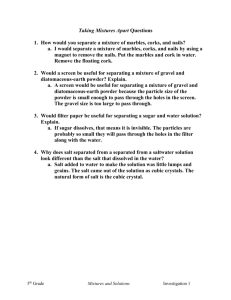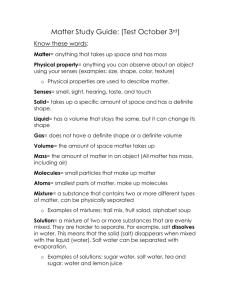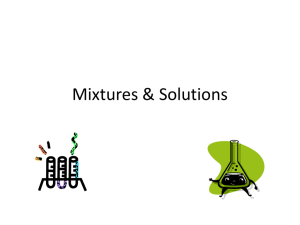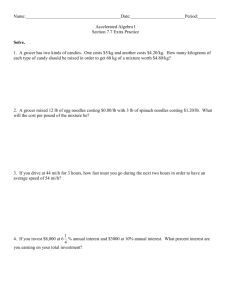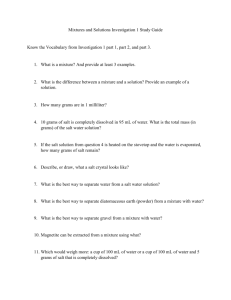Observing Crystals and Separating a Dry Mixture Lesson
advertisement
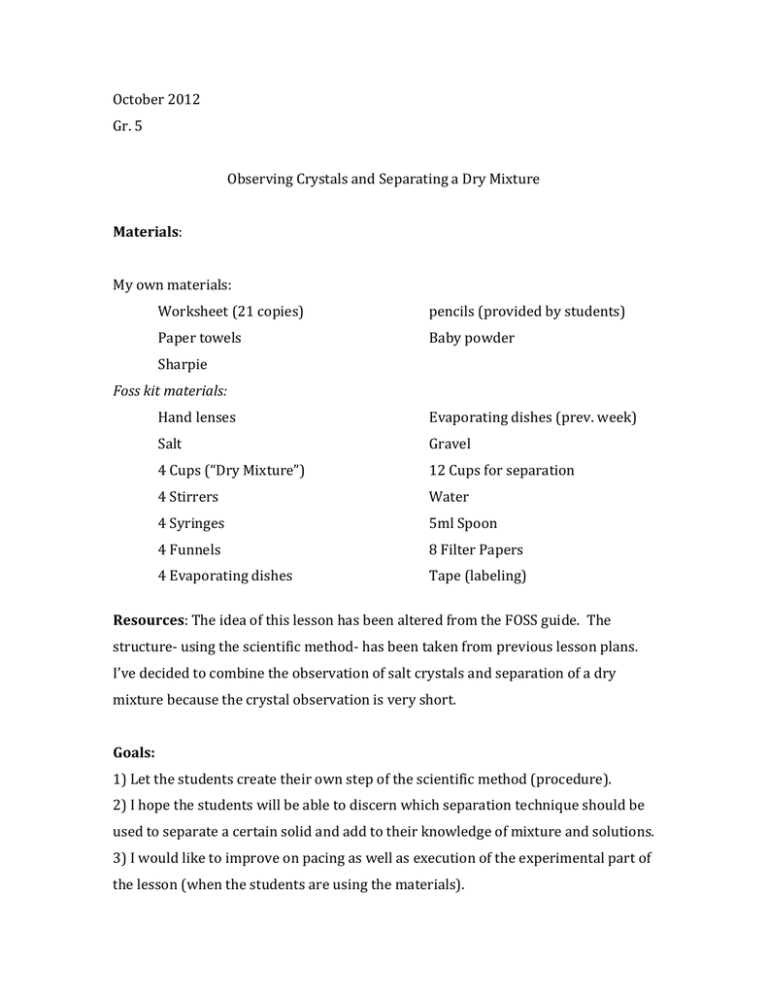
October 2012 Gr. 5 Observing Crystals and Separating a Dry Mixture Materials: My own materials: Worksheet (21 copies) pencils (provided by students) Paper towels Baby powder Sharpie Foss kit materials: Hand lenses Evaporating dishes (prev. week) Salt Gravel 4 Cups (“Dry Mixture”) 12 Cups for separation 4 Stirrers Water 4 Syringes 5ml Spoon 4 Funnels 8 Filter Papers 4 Evaporating dishes Tape (labeling) Resources: The idea of this lesson has been altered from the FOSS guide. The structure- using the scientific method- has been taken from previous lesson plans. I’ve decided to combine the observation of salt crystals and separation of a dry mixture because the crystal observation is very short. Goals: 1) Let the students create their own step of the scientific method (procedure). 2) I hope the students will be able to discern which separation technique should be used to separate a certain solid and add to their knowledge of mixture and solutions. 3) I would like to improve on pacing as well as execution of the experimental part of the lesson (when the students are using the materials). Objective: Students will learn about evaporation through the observation of salt crystals. Students will also be able to design a procedure on their own to separate a dry mixture. They will apply the steps of the scientific method in their designs. Procedure: NOTE: all materials and mixtures will already be prepared to cut down on time 11:45 : Hand out the evaporating dished to each group and allow them to examine the crystals. Have the following questions written on the board for the groups to consider: 1) What do you observe in the evaporating dish? 2) What happened to the water that was in the solution? 3) Does the salt look the same? CIRCULATE and make sure students are on task. Have the students fill out the worksheet and circle their predictions After 3 or 4 minutes, call the class to attention and go over the questions. Then define the word evaporation. Then add water to one evaporating dish and let the students observe and circle their results. At 12:00, let the students know their objective: “Today you will be given a dry mixture of salt, powder, and gravel. Within your groups you must design a procedure to separate these three materials. You can use any of the materials you see on the back table.” Have a student read the QUESTION. Then allow the groups to design their procedure (they should finish their procedures by 12:15) . Have groups raise their hands when they have fully written their procedure out in steps. CIRCULATE to make sure groups are on task and offer advice/ help when necessary. Once a group raises their hands, check their procedure, inform them of the results table and how to fill it in, and allow one person to go collect materials. Students should follow their procedure to separate the three solids and be writing in their results table if the separation technique was effective or not. If students are not on task remind them that you can take away their materials and that they will have to watch other groups perform the separations instead. Tell the groups that once all three mixtures are separated they should finish with the two conclusion questions and then clean up. If time is limited the instructor can clean up the materials. Assessment: Proper completion of the first half of the worksheet (answers should be the same), verbal responses to questions on board. The group’s procedure will be an effective way to see if they understand the separation techniques and which ones they should use for certain solids. Name_________________________ Observing Salt Crystals Evaporation:_______________________________________________ _________________________________________________________ Question: When you add water to the evaporating dish what happens to the salt? Hypothesis (circle one): The salt dissolves The salt does not dissolve Results & Conclusion: Did the salt dissolve? Circle one: YES NO Separating a Dry Mixture Question: How can you separate a mixture of gravel, salt, and powder? Procedure: (Write your group’s procedure to separate the three materials into different cups) Results: TABLE 1 What did you try to separate? (ex: gravel) What technique did you use? (ex: hands) Could you separate it? (YES or NO) Conclusion: Did your procedure separate all three of the materials? What improvements would you make to your procedure?

